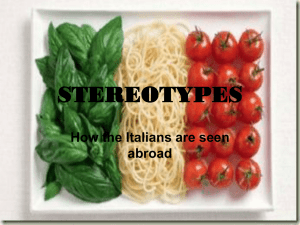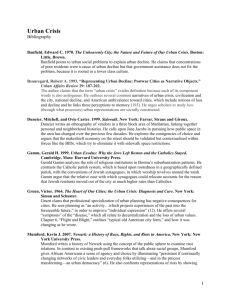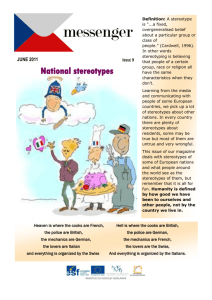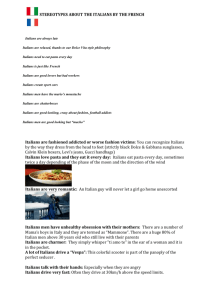Anthony Sorrentino, “It`s an Inside Job: An Italian
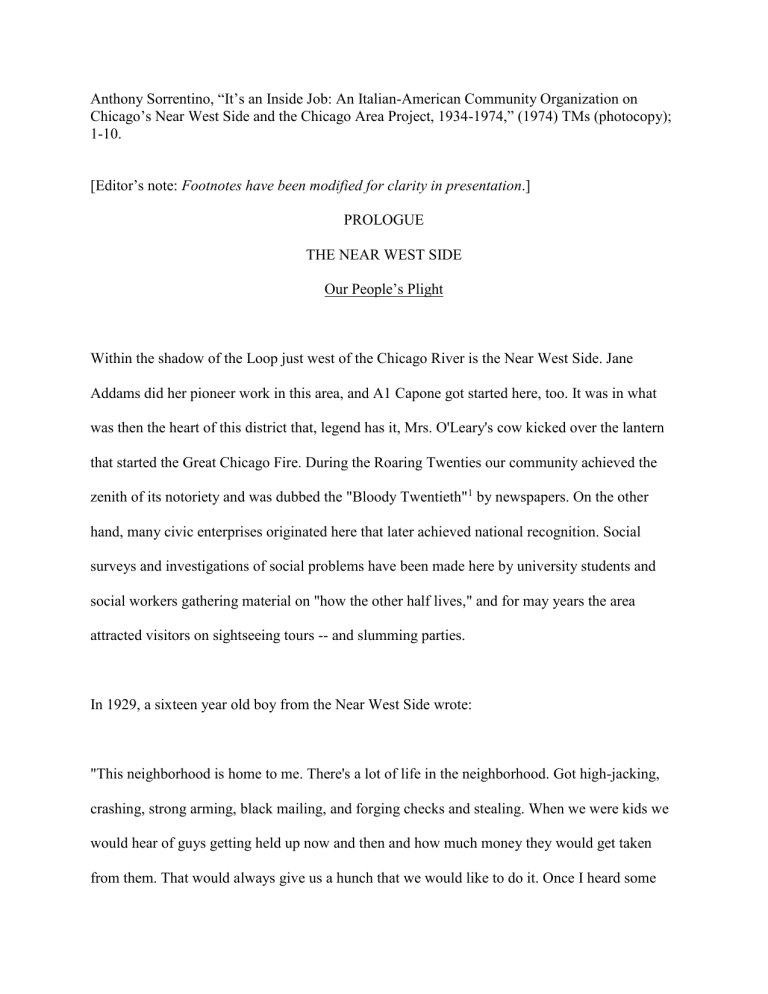
Anthony Sorrentino, “It’s an Inside Job: An Italian-American Community Organization on
Chicago’s Near West Side and the Chicago Area Project, 1934-1974,” (1974) TMs (photocopy);
1-10.
[Editor’s note: Footnotes have been modified for clarity in presentation .]
PROLOGUE
THE NEAR WEST SIDE
Our People’s Plight
Within the shadow of the Loop just west of the Chicago River is the Near West Side. Jane
Addams did her pioneer work in this area, and A1 Capone got started here, too. It was in what was then the heart of this district that, legend has it, Mrs. O'Leary's cow kicked over the lantern that started the Great Chicago Fire. During the Roaring Twenties our community achieved the zenith of its notoriety and was dubbed the "Bloody Twentieth"
1
by newspapers. On the other hand, many civic enterprises originated here that later achieved national recognition. Social surveys and investigations of social problems have been made here by university students and social workers gathering material on "how the other half lives," and for may years the area attracted visitors on sightseeing tours -- and slumming parties.
In 1929, a sixteen year old boy from the Near West Side wrote:
"This neighborhood is home to me. There's a lot of life in the neighborhood. Got high-jacking, crashing, strong arming, black mailing, and forging checks and stealing. When we were kids we would hear of guys getting held up now and then and how much money they would get taken from them. That would always give us a hunch that we would like to do it. Once I heard some
guys tell how they got a merchandise truck out on the road and would pull up along side and
[end page 1] pull the guy out of the car and let him walk the rest of the way home.
"They used to highjack booze joints. This is how little Hunkie got killed, high-jacking booze joints. There is very little forgery in my neighborhood. A little strong arming. We picked that up from the 42's
2
but big guys don't do that. Some nights on a busy street, well, you could get a guy and the other guys with you could strong arm him and you could get his jack. Sometimes we get some black mail. A lady got a black mail letter six years ago. They wanted six thousand dollars and she didn't have it. They didn't pay no attention to it until about two years ago and then they sent her another letter. The old man went crazy over it and they sent him to the hospital. He jumped out of a window and killed himself.
"But boy! We got lots of crashing,
3
me and Charles and Sam and Nick and Henry. We crashed lots of windows. Funny how it got started. All I remember is Nick brought it to our neighborhood. He picked it up from his brothers. His brothers don't hang around here. We hung around Halsted and Taylor. That is where we did all our crashing. We had customers before we'd get the stuff. We would go around before we crashed the store. We'd tell people that we had a lot of silk stuff and would bring it to them when it was dark. If we didn't have any buyers we'd go out and get some. The people that bought there were a few of them in the neighborhood and outside the neighborhood. We all went to the people that we knew." [end page 2]
"If we had of silk stuff and hats and things and the one that would pay us the highest price we would go to them. With tires it was different. People used to order their tires first and tell us to
get them for them. That is people like automobile owners and garage owners around the neighborhood and then we would go out and get the tires for them. When it came to things like candy and shoes we used to go out and find buyers first for them. We would tell them we had that kind of candy and they knew just what kind we could get for them if they wanted it. They all knew it was hot but they'd buy it because they could get it cheaper. We would get whole cartons of boxes. Sometimes in order to get a .buyer you just walk up to a guy and you ask them if they don't want to buy. If they don't want to they walk away. But before they do we tell them it is not every day they'll get stuff that cheap like that. But if you see they won't buy from you you just walk away from them."
4
* * * *
During the 1920's delinquency and crime flourished in this area, but these activities did not represent a new phenomenon. It is an interesting fact, verified by statistical studies, 5 that this district [end page 3] remained one of the areas in the city of Chicago where a large proportion of boys and young men engaged in crime. With reference to the occasional charge that certain nationalities are more "criminally inclined" than others, one can cite the fact that although, starting in the late nineteenth century, this district has been inhabited successively by Germans,
Irish, Jews, Scandinavians, Italians, Greeks, Mexicans, and Blacks, the proportion of boys and men involved in crime remained approximately the same.
Not only has crime followed a characteristic pattern for all these groups, but the problems and modes of living have been similar, too. For example, the Italian people, who were the majority here for several decades, upon settling in America were faced with the task of securing employment, establishing a home, and rearing their children in a new, strange but fascinating
world. As immigrants primarily from Central and Southern Europe, they came to America to seek better opportunities, but since the majority came with meager economic resources, where could they make their homes? The fashionable residential districts, where rents were forbidding and social barriers were rigid, were closed to them. They had only one alternative: to settle in low rent districts and crowded buildings close to the factories and mills where they were to labor.
Here for years they struggled to make a home and to rear their children to be productive citizens of America.
A large majority of the immigrant groups that preceded the Italians had achieved this goal. As these groups-the English, the Germans, [end page 4] the Irish-became better adjusted to
American community life, learned the language, and developed occupational skills, they moved up the social and economic ladder into better residential districts, better jobs, and higher status.
This process of assimilation and economic progress did not proceed so rapidly for later immigrant groups, such as the Italians, who came here from the predominantly agricultural economy of Southern Europe. In addition, many opportunities started disappearing at the beginning of the twentieth century. New frontiers were to follow, but they were of a different kind, accessible only to those of superior economic and intellectual attainments. Because preparation for these new opportunities required more education and training, and because pressure from new immigrant groups was lacking, the Italians had to remain in the inner areas of the city for a longer time than earlier immigrant groups.
The Italians, like other immigrants, found the struggle for survival in America at times almost overpowering. But in spite of the harshness of urban living and the unattractive industrial
environment into which they were thrown, most of them set to work with determination and zeal to obtain some of the fruits of this land of plenty, and they, like other minorities, have in time made valuable contribution to American culture, though many Italians still live in or adjacent to low-income areas.
In the early days of immigration
6
it was quite natural for the [end page 5] Italian immigrant to live in provincial groups, paesani (countrymen) from the same village or town gathering together in the same block or neighborhood of the city. The Sicilians clustered in large numbers on the
Near North Side, while the Neopolitans, the Calabrese, the Barese, the Abruzzese, and also some
Sicilians colonized certain parts of the Near West. Side. These provincial groups furnished the basis for social organization in the early days of settlement. As a result, the Italians did not constitute a unified or homogeneous group. Each of the provincial groups was differentiated from the others by customs, dialects, and history. With the passing of time, however, there has been considerable intermarriage, not only among those from different provinces but also with those of other national and ethnic backgrounds, and the cultural differences between provincial groups are fast disappearing. One finds some remnants of these differences only in the humor of the younger ,people who good naturedly mimic the traits and customs of the different provinces.
In the early days, most of the village and provincial groups organized mutual benefit societies to help in cases of sickness and death and to carry on their social life. Many of these societies were identified with Italo-American National Union or the Order of the Sons of Italy, and some were organized on an independent basis. The relationships in these early mutual benefit societies were close and personal, for the provincial ties fostered a spirit of kinship among their members, but
as the Italian population moved out of the inner city, many people abandoned these societies.
Some continue to exist with the children of immigrants, and some of the older [end page 6] members continue to belong, but by 1950 they no longer constituted a significant aspect of the social organization of Italian immigrants. The societies of the early 1920's that paraded through the streets of the Near West Side and Near North Side on Sunday mornings, marching in procession with the statue of their patron saint--they are no longer. The primary reason for joining one of the remaining fraternal organizations today is for insurance and some social benefits, a far cry from the needs and pressures that were at work in the early immigrant community.
Although not a major problem today, fifty years ago Italian immigrant parents tended to lose control of their children. The parents had little or no opportunity to make an adjustment to their new environment, since contacts were limited largely to neighbors or friends who had the cultural background and who were in a similar state of assimilation: they continued to reflect the attitudes and sentiments of the old world culture. The children, already incorporated into neighborhood groups and exposed to the traditions of delinquency endemic in the community, began to act in ways their parents disapproved of. This situation created two worlds: the youngsters were gaining sophistication in the American way of life, while their parents upheld the customs and values of the old world. The parents attempted in their feeble ways to force their offspring to conform to old world standards, but the only result was that the children disregarded parental authority and cultivated anti-social attitudes and unconventional types of activities: truancy, petty stealing, larceny, sex delinquency, and other crimes, each having a disintegrating effect on [end page 7] family organization.
A deep sense of inferiority was manifested is different ways by some of our people: this was a feeling kept alive by the low status we occupied because of limited economic opportunities, and by the way we were viewed by people on the outside who in subtle or direct ways regarded us as inferior. The outsider had little understanding of the problems our parents had in raising their children and in attempting to provide adequate opportunities for health, recreation, education, and housing in this community. Our poverty and inability to meet these needs adequately was often interpreted by the wider society as proof of our inferiority. The attitudes of the larger society toward our community were expressed in various ways. Of the many examples that come to mind, here are a few.
Two young men sat around their clubroom indifferent, bitter, and hard. When I asked about their frame of mind they first cursed and blasphemed the whole universe. For the moment these young men seemed to have lost all hope. What terrible thing happened to them? Having gone for a job where they knew there were openings, they had been given the "cold shoulder" with the usual
"We'll let you know." Outside, they met a friend who sympathetically chuckled that they'd better forget all about it. He explained that the manager was not hiring Italians from that area because of its "hoodlum background." Here were two small, easy-going young chaps who had not been engaged in crime but who were suspected of being criminals. "God damn it, if people think we are hoodlums, well then we ought to be." Their profuse swearing was an indication of the hardening process that goes on in the slum. [end page 8]
Some friends of mine from Taylor Street, a well known thoroughfare which connotes "Little
Italy," moved out of the area a few years ago into a community occupied predominantly by native Americans. This young couple hadn't lived there a week before rumors and gossip about them began to bounce around to this effect: "Be careful about those Italians, especially those from Taylor and Halsted." A few months later, an elderly couple who lived in the building next door was robbed of $9,000 in cash. The young Italian couple was immediately suspected-the first house the police pounded on was theirs. A group of stern and determined policemen was about to prance in when the young wife asserted herself and called them down for their militant attitude.
They calmed down and questioned her and got their information, then left. This young man was a conscientious, law-abiding citizen, a skilled workman with a quiet, devoted love for his family.
As he told the story with hurt feeling he said, "Yes, we Italians from the Near West Side sure got a bad reputation, but nobody is going to push me around like those cops tried to."
This is not to single out the police; they were no more or less kindly disposed toward our people than the wider society was. But over the years they operated in our community with an aggressive, "crack down" and "push them around" policy-that is, until later, when our people assumed a more commanding position. But even after that happened, many of our younger men remembered the old approach and were still subjected to it in milder forms. Some chaps from a club in our area related the following story to illustrate how "the cops still pick on us." A young man, whom they stressed was absolutely above reproach as regards his law-abiding conduct-a steadily employed worker, frugal and serious minded-was [end page 9] stopped as he was driving his newly purchased car. The police suspected him of something and directed him to drive to the station for questioning. As they were driving there a bunch of fellows from the
corner spotted him and guessed the situation. They whistled for a political leader who happened to be nearby and he stopped the police. When the police were given the chap's background, they left him alone in a hurry. [end page 10]
1 The Twentieth Ward, it's now part of the First Ward.
2 a gang of older boys
3 running a car through the window of a store to be burglarized
4 From Life History #21, Institute for Juvenile Research
5 See Clifford R. Shaw and Henry D. McKay Juvenile Delinquency and Urban Areas, rev. ed. (Chicago: University of Chicago Press, 1969)
6 By about 1925 America had closed its door to mass Italian immigration. After the Federal Immigration Act of
1924, immigration from Italy and Southern Europe generally was permitted on a restricted quota basis which favored the earlier immigrant groups. It was not until 1968, when the discriminatory Walter-McCarron Act was repealed, that the restrictions on immigration from Southern Europe were modified so as to permit a larger proportion of immigrants from there to come to the United States.



